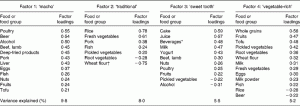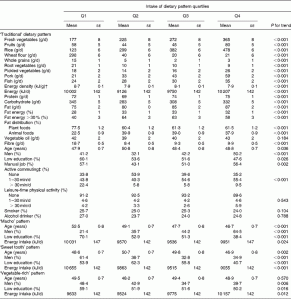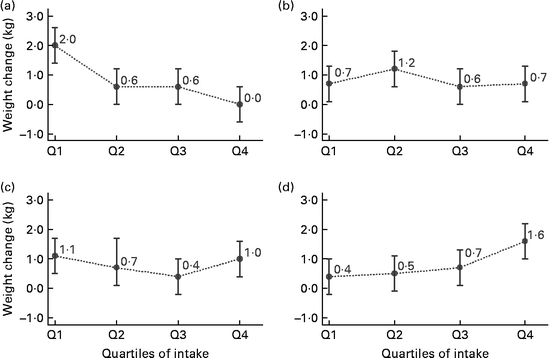You’re going to hate me. This isn’t the wheat post, which means I’ve broken my “wheat is next” promise for the 80th time and should never be trusted with anything again ever. But during my nightly Pub(Med) crawl, I saw this nearly-new gem of a study glimmering in the dust and said to myself, “Wow. Wow! Wow.” By the third wow, a blog post was inevitable. So here it is. I promise this is truly interesting (not that me promising things matters anymore).
But first, some background.
A few years ago, a study hit the stands with the audacious title Vegetable-rich food pattern is related to obesity in China. The paper showed that among four diet patterns—“macho” (meat and alcohol), “sweet tooth” (sugary drinks and cake), “traditional” (rice, vegetables, pork, and fish), and “vegetable-rich” (vegetables, wheat, whole grains, and fruit)—only one had any relationship to obesity: the vegetable-rich pattern.
The study didn’t exactly receive a lot of press, probably because no one wants to think vegetables make people fat (including the researchers, who hummed and hawed their way to a half-baked conclusion—check out this post by Michael Eades). And as Stephan Guyenet explained, the study really showed a trend between wheat intake and weight gain, with the pounds rising as wheat replaced rice as a staple.
I mention this because the new study is actually a follow-up to the old one. It tracked changes in the participants’ weight over the span of five years, using the same method of divvying up food consumption into distinct diet patterns. In fact, here’s the table with their “factor loading” system, showing how various foods were weighted to determine adherence to each diet pattern. (Go ahead, click on it. You know you want to.)

I’m going to explain this study point-by-point before getting to the good stuff, because it’s a little complicated (but totally worth understanding).
Note that only two patterns use wheat as a factor: the “traditional” and “vegetable-rich” diets. The traditional pattern loaded inversely on wheat flour and positively on rice, whereas the vegetable-rich pattern loaded inversely on rice and positively on wheat. In simpler terms, that means the “traditional” pattern is rice based and the “vegetable-rich” pattern is wheat based. These two patterns are polar opposites in terms of their staple grain. The “macho” and “sweet tooth” patterns don’t take grain consumption into account.
After the researchers schemed up these diet patterns, they divided everyone into quartiles of adherence. Folks in the first quartile of any pattern had the lowest adherence to it, whereas folks in the fourth quartile ate diets most in line with that particular pattern. The paper only gives a detailed breakdown of the “traditional” diet quartiles and smaller summaries of the other three, but you can still see how food intake changes from quartile to quartile:

From the paper:
A clear increasing trend of the intake of fat was seen across quartiles of the ‘traditional’ pattern from low to high. Participants in the first quartile of this pattern had the highest intake of wheat flour and dietary fibre compared with the other groups. … There was a significant negative association between the ‘traditional’ pattern and energy density.
Darn right. The first quartile boasts an average wheat intake of 298 grams per day, versus only 21 grams in the fourth quartile. And fat intake rises from 75 to 87 grams per day from the first to fourth quartile. Energy density (calories per gram of food) also drops, although the researchers don’t mention that total energy intake (calories) is actually highest in the fourth quartile.
The researchers also note that “across quartiles of the ‘vegetable-rich’ pattern, the intake of energy, wheat flour and vegetable oil increased.” Most of that info didn’t make it into any tables, so we’ll just have to take their word for it.
Now here’s where it gets interesting.
The following table shows the five-year weight change for the different quartiles of each diet pattern. Remember that the “traditional” and “vegetable-rich” diets are the only ones defined—at least in part—by wheat consumption (or lack thereof). (A) is the traditional pattern, (B) is the macho pattern, (C) is the sweet-tooth pattern, and (D) is the vegetable-rich pattern.

What stands out here? How about this:
After adjustment for age, sex and baseline weight, the ‘traditional’ dietary pattern was inversely associated with weight gain, while the ‘vegetable-rich’ pattern was positively associated with weight gain. … No significant associations of the ‘macho’ and ‘sweet tooth’ patterns with weight gain were found.
What interests me is that the largest change in weight out of any of the graphs—1.4 kilograms—occurs between the first and second quartile in the “traditional” pattern. This corresponds with a drop in average wheat intake from 298 to 40 grams per day. (Without knowing the actual per-quartile numbers for the “vegetable-rich” pattern, it’s impossible to say how changes in wheat consumption match up with that graph, although the researchers already stated that wheat consumption rises throughout the quartiles.)
The inverse relationship between the “traditional” pattern and weight (and therefore wheat and weight) doesn’t seem to be confounded by other factors, either:
In the stratified multivariate analyses, an inverse association between the ‘traditional’ dietary pattern and weight gain was present in subjects aged < 40 years and ≥ 40 years, in non-smokers and smokers, in overweight and normal-weight subjects, in alcohol drinkers and non-drinkers, and in men and women. There were no significant interactions between any of the above factors and the ‘traditional’ dietary pattern with weight gain.
The connection between wheat and weight was so prominent in this study that the researchers (who carefully tiptoed around the subject in their 2008 writeup) couldn’t beat around the bush any longer. They slammed the “discussion” section with a giant wall of wheat text. Since I’m not sure how long the study will be available for free, I’ll quote the relevant parts right here (interspersed with some commentary):
A large difference in the intake of rice and wheat flour was found across quartiles of the ‘traditional’ dietary pattern. It represented two different sub-patterns with two different staple foods in inverse proportions, i.e. rice and wheat.
(No quibbles there. But the next part is where they try painfully hard to rationalize the wheat-weight connection.)
Rice is a low-energy food that contributes to the bulk of the traditional diet. Compared with wheat, rice absorbs more water when cooked. In addition, different cooking methods are used in preparing these two staple foods. For instance, steamed rice contains twice the amount of water and half of the energy compared with steamed bread(17). Thus, the energy density of the rice staple diet is usually lower than the one based on wheat.
(Regardless of energy density, the fourth quartile for both diet patterns show that the rice-based pattern had a higher average calorie intake than the wheat-based pattern, yet lower five-year weight gain—0.0 kilograms versus 1.6 kilograms.)
Since the content of wheat was only predominant in the first quartile of this dietary pattern, this may partly explain the negative association between the ‘traditional’ pattern and weight gain in the present study.
(Ding, ding, ding. But is it because wheat has lower water content, as they suggest, or does our favorite grain somehow wreak metabolic havoc? The weight changes in the “traditional” pattern echo wheat consumption more consistently than total energy intake.)
Also, this association could not be explained by fat intake, since a higher intake of the ‘traditional’ pattern was associated with a higher intake of fat. Intake of fibre was the highest among people in the first quartile of the ‘traditional’ pattern. Thus, the benefit of weight maintenance of the traditional dietary pattern was not related to dietary fibre.
(Blasphemy! How did such nonsense pass peer-review?)
The reason I find this so fascinating is that it perfectly corresponds with the patterns in the Oxford-Cornell China Study, which showed that wheat was the single biggest contributor to BMI out of any diet variable. Calories didn’t matter. Fat didn’t matter. Weight followed the wheat.
I recommend reading the full study before the Powers That Be shove it behind a pay wall (or before the wheat industry files a lawsuit). And I’d say my real wheat/heart disease post is coming up next, but I don’t want to jinx myself. It’s on the way, though. I promise (?).


